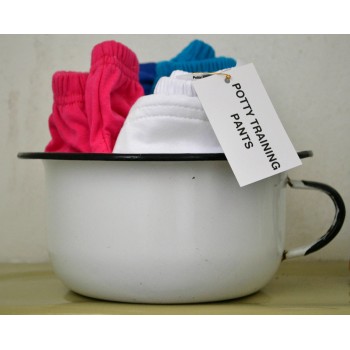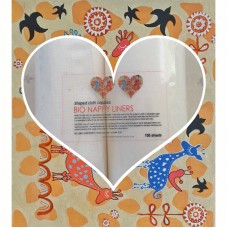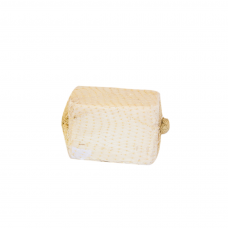Potty Training Pants
Description: Toddler potty training pants are useful in assisting toddlers to learn bladder control (by experiencing the sensation of feeling wet). They do not replace a nappy in absorbency but are useful in preventing “little accidents”. This is especially useful during playschool hours or when out and about.
Big Boy or Girl! Bridging the gap from nappy to pants: The trainers pull up and down and look like ordinary underwear but with an absorbent saddle made from our bamboo toweling plus a breathable waterproof layer between 2 layers of soft cotton fabric.
User Tip: You can either use the potty training pants as they are without a liner or if you prefer, use our fleece nappy liner of bio liner inside. Line the inside of a potty to easily clean up the mess! Another option is to add a bamboo insert (cloth nappy page) to add absorbency is used at night.
Washing instructions: Cool or warm wash in a washing machine or by hand. Line dry only to preserve the waterproof saddle.
Size 2- 3 years:
Weight 8 – 18kg
Waist (diameter) 40 – 45 cm
Thigh (upper diameter) 37 cm
Belly to bottom rise: 40 cm
Size 3-4 years:
Weight 12 – 22 kg
Waist (diameter) 50 – 55 cm
Thigh (upper diameter) 45 cm
Belly to bottom rise: 52 cm
NEW: Size 4-5 years - Size 4-5 years are made on request only
Weight: 20 kg plus
Waist (diameter) 55 - 63 cm
Thigh (upper diameter) 50 cm
Belly to bottom rise: 54 cm
How do I potty train, my toddler?
Potty Training Essentials:
(Written by Joanne Austin and Nicky Mee of Mother Nature Products (www.mothernatureproducts.co.za)
Is our big
boy or girl ready? This challenging question is raised by parents around the
world and what parent doesn’t want to get their child out of nappies! On
average children start potty training between the ages of 2 to 3 years. Once
you have gone through our signs of readiness there really is only one way to
find out – give it your best go.
Signs your toddler is ready:
Starting
potty training earlier doesn’t necessarily mean finishing early; so be patient.
In their first year, babies don’t have bladder muscle and nerve control. This is
something that develops at differing ages from child to child. Here is a
checklist of signs they are ready:
- Shows general interest and
independent thought
- Is co-ordinated (running, walking,
balance)
- Follows simple instructions
- Developing a regular toileting
routine
- Has dry periods of 2-hour intervals
- Can pull pants up and down
- Dislikes the sensation of being wet
or soiled
- Grunting or squatting during bowel
movement
- Shows an interest in the toilet
- Dancing or hopping about when the bladder
is full or during bowel movement
|
Equipment: sturdy potty
or an inner seat to fit over your toilet, block to stand on to reach the
toilet, bright and fun cloth potty training pants (such as Mother Nature
Potty training pants) which have an absorbent saddle, bed mattress protector
(such as Mother Nature’s breathable version), rewards chart. |
Tried
and tested tips by our really wise parents: We asked our a panel of parents what worked for them and are some great ideas they have tried:
- Remember the three P’s: patience,
positivity, praise
- Call your child the “king or queen”
of their “throne”
- Familiarity is king: introducing them
early to the toilet, regular hourly visits to the bathroom, learning from their
parents
- Let your child lead you: they will
let you know when they are ready
- Sing songs, read stories and make
“ssswwiss” sounds while they are seated
- Reward ideas: small chocolates, biscuits,
favourite food, play outside, stickers, allowed to flush, get to wash hand
afterward, get to draw on the toilet with a washable koki, dye the toilet water with food colouring
- Clap hands and cheer when they get it
right
- Create a happy toilet story: An
example is that the “yuk-yuk” goes to the sea to feed the fish when it is
flushed and then say goodbye.
- Use cloth nappies as opposed to
disposables and get your child trained earlier
- Make it seem like a fun and exciting
game
- Easy clothing: dress girls in dresses
for easy action or remove bottom clothing in the beginning phases
- Boy tip: put 5 Cherios in the bottom
of the potty and get them to aim ‘n shoot
- Remove smelly odors caused by
accidents by covering the spot with salt then vacuuming it up ½ hour later
- Remember it’s not mission impossible
so hang in there folks!
- Messy Potty Tip: Use
Mother Nature’s biodegradable & flushable liners to line the bottom of the
potty. After use, flush them down the toilet! No need to deal with a messy,
dirty potty!
- Lay-off liquids at least 1 hour
before bedtime
- Take them to the toilet before their
bedtime as well as your bedtime. Perhaps
set alarm for midnight to take them again.
And ensure they go to the toilet as soon as they wake up.
Potty
training is not always a smooth sailing process as some children can be
extremely resistant to the potty training process. Children who are refusing to potty train may
be experiencing confusion about what's expected of them, as well as emotional
fears, painful physical sensations, or just general rebellion. Causes may include:
- Willfulness to control the situation
by refusing to co-operate
- Fear of the toilet or negative potty
training experience
- Medical reasons – speak to a
pediatrician
- Psychological reasons: life crisis,
negative comments, or teasing by family members which in turn leads to a lack of
confidence & shame
- Problems more common in boys
- Immaturity of the nervous system in
recognizing the sensation of being wet during sleep or the sensation of a full
bladder
- Other medical causes of enuresis are sleep apnoea (snoring), pin-worm infection, diabetes, family history. May need to be referred to a urologist for
evaluation
#toddler #pottytraining





-74x74.jpg)





